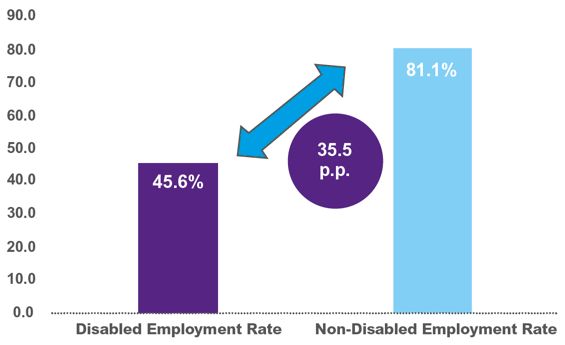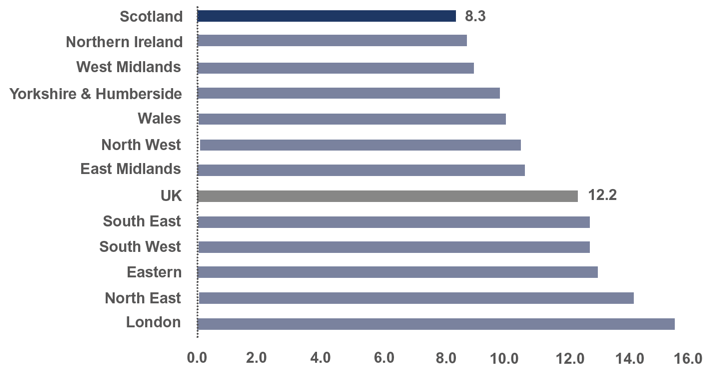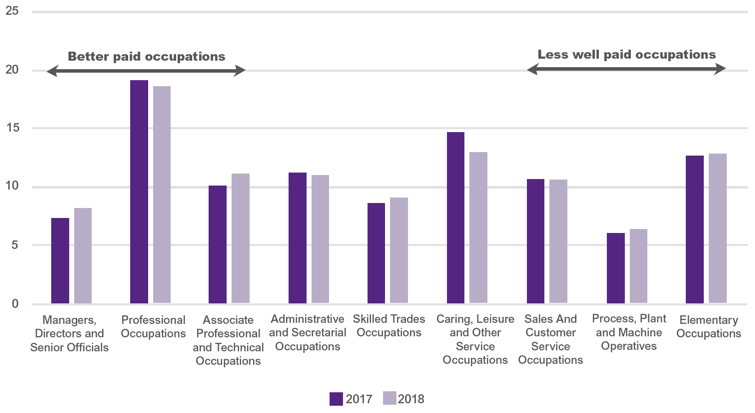A Fairer Scotland for Disabled People Employment Action Plan - Progress Report
This document provides an update on progress achieved in the first year of implementing A Fairer Scotland for Disabled People: Employment Action Plan.
3. Measuring Progress
In A Fairer Scotland for Disabled People: Employment Action Plan, we identified key indicators against which we would report on an annual basis in order to measure progress towards achieving our overall objective of at least halving the disability employment gap in Scotland by 2038. This section provides an update of these by theme.
3.1 Halving the Disability Employment Gap (DEG)
The Disability Employment Gap (DEG) is the difference between the employment rates of disabled people and non-disabled people. In 2016, when we set our aim to at least halve the DEG, this was 37.4 percentage points (p.p.). Since 2016, Scotland's DEG has fallen: to 35.9 p.p. in 2017; and to 35.5 p.p. in 2018. The narrowing of the gap since 2016 has been driven by a rise in the employment rate of disabled people.


3.2 Interim Milestones
In the Action Plan we set out two interim milestones to help us track progress towards halving the DEG:
A) to increase the employment rate of disabled people to 50% by 2023; and
B) to 60% by 2030.
To reach these milestones, and ultimately halve the gap, the employment rate of disabled people will need to increase by at least 1 percentage point every year. We are on-track with this so far. The employment rate of disabled people has increased by 2.8 percentage points over the last two years - from 42.8% in 2016, to 45.6% in 2018.

3.3 Young People and Transitions
In 2018, the employment rate of disabled 16-24 year olds was 35.8%, slightly higher than the baseline rate of 35.6%, but 7.2 percentage points lower than the rate in 2017 (43.0%). The employment rate of non-disabled 16-24 year olds also declined between 2017 and 2018.

Source: ONS Annual Population Survey, Jan-Dec 2016-2018
Although the employment rate for disabled 16-24 year olds has declined over the latest year, the unemployment rate for disabled 16-24 year olds has also fallen – from 20.8% in 2017, to 17.9% in 2018. The shift has been towards inactivity – in terms of the labour market, 'inactivity' refers to people not in employment, who have not been seeking work within the last 4 weeks and/or are unable to start work within the next 2 weeks.
The inactivity rates of both disabled and non-disabled young people increased over the year, although the rise in inactivity for disabled young people was greater.
For 16-24 year olds as a whole, inactivity due to: being a student; long-term sickness; and looking after family/home have all increased as reasons for being inactive over the year[1]. The proportion of young people as a whole who are inactive due to long-term sickness has increased from 6.3% to 8.0% in the past year. So this shift towards inactivity may be partly driven by an increase in young people identifying as disabled who are already inactive rather than an increase in inactivity among young disabled people.
3.4 Supporting Employers to Recruit and Retain Disabled People
Whilst it is not possible to report on individual employers' recruitment and retention levels of disabled people in this report, the disability pay gap provides a measure of equality for disabled people in employment. It represents the difference between average hourly pay of disabled and non-disabled people, as a percentage of non-disabled people's pay.

In 2018, average pay for disabled employees in Scotland was 8.3% lower than non-disabled employees. This means for every £1 that a non-disabled employee earned in 2018, a disabled employee earned £0.92.
Scotland's Disability Pay Gap has declined since 2016, and in 2018, Scotland's gap was the smallest of all UK nations and regions. However, this data is volatile for Scotland which can make it difficult to identify consistent change over time.

Source: ONS, Disability Pay Gaps in the UK: 2018
3.5 Supporting Disabled People to Enter Employment
Types of occupations that people move into
Disabled people are employed across all sectors of Scotland's economy and across all occupation types. However, disabled people are generally under-represented in the better paid occupations in our labour market and over-represented in lower paid occupations.
Progress has generally been positive over the year with a shift towards better paid occupations for disabled people. The proportion of disabled people employed as Managers, Directors and Senior Officials (on average, the highest paid occupational group) has increased – from 7.3% to 8.0% – although the proportion of disabled people employed in these roles still falls short of the proportion of non-disabled people (8.5% in 2018). And the share of employment of disabled people working in associate professional and technical occupations increased from 10.1% to 11.1% over the year, although there was a slight decline for professional occupations (19.0% to 18.6%).
For less well paid occupations, there was a fall in the share of employment of disabled people over the year for all occupation groups except elementary occupations and process, plant and machine operatives.

Source: ONS Annual Population Survey, Jan-Dec 2017, 2018
Changes in how disabled people move in and out of employment
Moving into work
The proportion of disabled people moving from out of work into employment has increased over the year and increased since the baseline year – from 7.0% in 2015/16 to 8.4% in 2017/18.

Scottish Government Analysis of Labour Market Flows based on the Annual Population Survey
Falling out of work
Labour market flows analysis shows there has been an increase in the proportion of disabled people who have fallen out of work over the latest year but a fall from the baseline year.

Scottish Government Analysis of Labour Market Flows based on the Annual Population Survey
Over the last year, the proportion of disabled people in employment who have fallen out of work has increased – from 8.2% in 2016/17, to 10.0% in 2017/18 (although it also increased for non-disabled people - from 4.9% to 5.5%). Disabled people remain generally around twice as likely to fall out of work as non-disabled people (10.0% vs 5.5%).
3.6 Intersectionality
We recognise that disabled people can experience barriers to employment on the basis of multiple characteristics, including gender, ethnicity, sexuality, etc. In policy terms, we refer to this as intersectionality. When someone has multiple protected equality characteristics they are likely to experience greater disadvantage in the labour market.
Gender
Disabled women will generally face greater labour market barriers than non-disabled women and the experience of women in Scotland's labour market tells us that disabled women will face greater disadvantage than disabled men. However, although for Scotland's labour market as a whole the employment rate of men is consistently higher than women, disabled women had a higher employment rate than disabled men in 2018 (46.2% vs 44.8%).
Rates of economic inactivity can help explain this. Whereas for non-disabled people, women are around twice as likely to be inactive than men - driven by women being much more likely to be looking after the family/home than men - for disabled people, rates of inactivity are similar by gender. This is because 'sickness' is overwhelmingly the most common reason given for inactivity by both disabled men (74.5%) and women (56.5%). (ONS, Annual Population Survey, Jan-Dec 2018)
Race
The employment rate of people from minority ethnic groups in Scotland is consistently lower than the employment rate of white people. And for people from minority ethnic groups who are disabled, multiple disadvantage and labour market barriers are reflected in a lower employment rate (37.9%) than people from minority ethnic groups who are not disabled (57.8%). A non-disabled white person is more than twice as likely to be in employment (82.4% employment rate) than a disabled person from a minority ethnic group (37.9% employment rate).
However, the minority ethnic employment gap – the difference between the employment rates of white people and people from minority ethnic groups – is much smaller for disabled people (8 percentage points) than non-disabled people (24.6 percentage points). This is primarily because disability has such a big impact on employment rates, that rates for disabled people are low – regardless of race. (ONS, Annual Population Survey, Jan-Dec 2018)
Qualifications
The disadvantage faced by disabled people with lower qualifications is evident in the particularly low employment rate (40.2%) for disabled people with below degree level or no qualifications. But even with a degree or higher qualification, disabled people are still less likely (67.2% employment rate) to be employed than non-disabled people without one (78.3% employment rate). Non-disabled people with a degree had an employment rate of 86.6% in 2018, almost 20 percentage points higher than equally qualified disabled people.
However, there are indications that obtaining a degree improves the employment prospects of disabled people more than non-disabled people, and can act to reduce the disability employment gap. Having a degree boosts the employment rate of disabled people by 27 percentage points compared with 8.3 percentage points for non-disabled people. (ONS, Annual Population Survey, Jan-Dec 2018)
Further information
The Scottish Government publishes analysis of a range of labour market data on its website. You can find additional information and data tables about disabled people in the labour market from the Annual Population Survey Jan – Dec 2018 here.
Contact
Email: sarah.wardrop@gov.scot
There is a problem
Thanks for your feedback